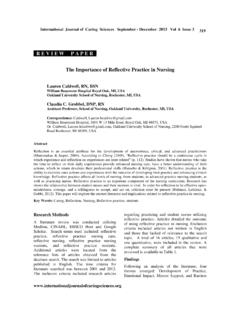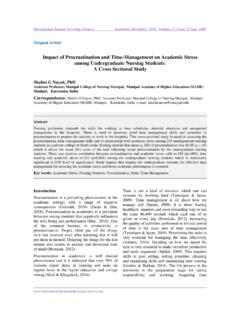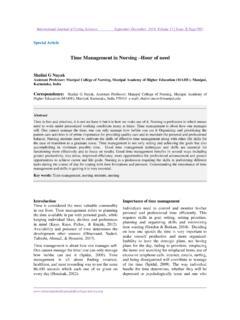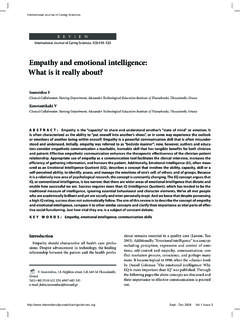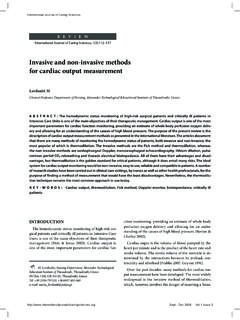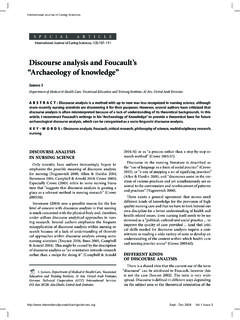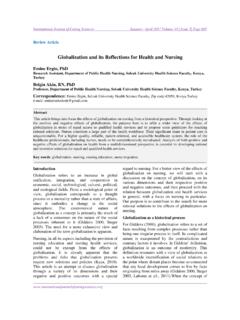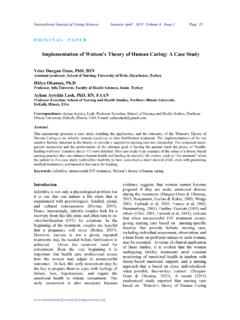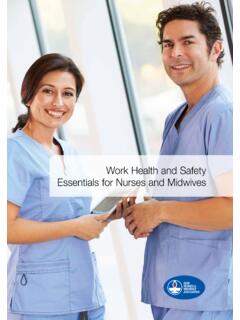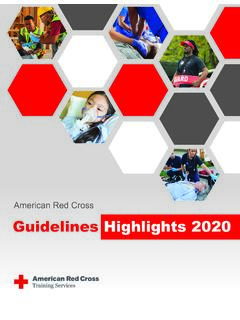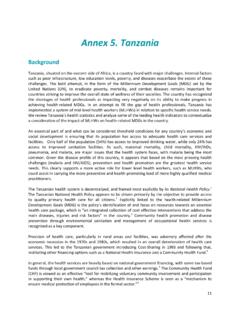Transcription of The Method of Checking Medications Prior To Administration ...
1 International Journal of Caring Sciences September-December 2015 Volume 8 | Issue 3| Page 801 Review Article The Method of Checking Medications Prior To Administration : An Evidence Review Efstratios Athanasakis, BSc, RN Staff nurse , Royal Albert Edward Infirmary, Wrightington, Wigan and Leigh NHS Foundation Trust, Wigan, United Kingdom Correspondence: Efstratios Athanasakis, 6 Newton Close, WN1 2LH, Wigan, Lancashire, United Kingdom. E-mail: Abstract Background: Checking Medications before their Administration by nurses is a basic preventive action for medication errors. Due to the fact that nurses perform medication Checking in the everyday clinical practice, either on their own (single) or with another nurse (double) and are responsible for what they administer to the patients, Checking is directly related to nursing.
2 Mostly the last years, queries around multiple issues about Checking have been raised. Aim: The present review was undertaken in order to collect and appraise research evidence about the Method of medication Checking (single and double) Prior their Administration . Methodology: A literature search was undertaken to PUBMED, SCIENCE-DIRECT, BRITISH NURSING INDEX and CINAHL databases using specific keywords for relevant articles (of qualitative, quantitative, mixed methodology) published in English from January 1990 to March 2015. For the introduction of an article to the review, specific inclusion criteria were set. Additional data obtained through relevant reports from institutions and the articles references. The selection process of the articles was based on the flowchart which was recommended in the PRISMA statement. Results: Twenty primary research studies and three reviews were included in the review and their data was clustered according to the analysis of studies findings: definition inconsistency, single- Checking , double- Checking , cases of Checking application, benefits and drawbacks of Checking , medication errors and promoting and supporting ways for Checking Method .
3 Conclusions: The present review gathers current evidence about medication Checking Prior their Administration , either single or double. Yet data is limited and ambiguous, implying the need for additional research in the field, so that the subject would be investigated in depth with safer and accurate conclusions. Keywords: nursing, medication preparation, medication Administration , single Checking , double Checking , medication error. Introduction The procedures which are entailed in the management of patients medication comprise fields of clinical practice where the risk of medication errors is high (Schelbred and Nord, 2007). The lack of Checking habits is considered to be one of the contributing factors for medication errors and specifically those related to staff. Importantly, the implementation of double- Checking Method should be stressed at the undergraduate level of professionals education (World Health Organization, 2011).
4 In order to prevent medication errors occurrence during medication preparation and Administration a variety of specific methods and techniques is followed (Choo et al, 2010; Athanasakis, 2012). Towards to the direction of safety insurance and care quality, the utmost measure that is adhered by nurses during medication Administration is the appliance of the five rights: right patient, right medication, right dose, right route, right time, even though the last few years some researchers International Journal of Caring Sciences September-December 2015 Volume 8 | Issue 3| Page 802 tend to consider as vital more rights than the five mentioned above (Wilson et al, 2004; Elliot and Liu, 2010). Alongside with the five rights goes the measure of Checking (single or double), which is used as a system-based strategy to address the combination of the health system complexity and the human factor that lead to errors.
5 Strategies to prevent medication errors it s better to be applied concurrently with and never in isolation of other strategies (Paparella, 2013, p. 632). The main objective of the above methods appliance is to follow every step of the medication procedure effectively and minimise any potential harmful medication errors, particularly the medication Administration errors. Double- Checking was evidenced as a mode to discover actual errors and near misses or prevent serious medication errors ( route medication error: preparation of intravenous (IV) metronidazole instead of oral) (Manias et al, 2005; Sheu et al, 2009). In addition, medication Checking was the third category of nurses thinking during medication Administration (Eisenhauer et al, 2007). Besides, the Checking Method is directly related with nurses, since they hold key-role in the medication procedures, thus it is possible to identify the error in time before the medication will be administered to the patient (Tran and Johnson, 2010).
6 Guidelines of professional bodies and policies The British Nursing and Midwifery Council first published in 1986 a medication Administration guideline. According to this, the second person should be involved in the medication Administration with a first-level practitioner when that practitioner is instructing a learner or the patients condition makes it necessary or in such other circumstances as are logically determined . Also, it is recommended that that the second-level practitioner ( the enrolled nurse ) should have undertaken medication training and assessment in order to participate in the medication Administration process (Nursing and Midwifery Council-NMC, 1986). In 2010 in its report about safe medicine management, stated that Prior medication Administration every registrant (registered nurse , midwife, specialist community public health nurse ) should check with another one about patients allergies, inform patients and ask their consent, check the details of the prescription (substance, timing, strength, dose, frequency, route, date), check the way it is written (legible, clear, reasonable, authorized signature) and patients identity (NMC, 2010).
7 Another published medication safety alert, coming from Canada and published over a decade ago by the Institute for Safe Medication Practices (ISMP Canada, 2003), discussing the virtues of independent double checks. Since then, various publications came out by the same institute and provided further insights to the subject, by expanding the knowledge of the independent double- Checking definition, whilst providing steps about its performance, by providing examples of the clinical practice, relevant thoughts and nurses perspectives (ISMP Canada, 2005; 2009; ISMP USA, 2008). In the last concerning report of USA ISMP, independent double checks were characterized as undervalued and misused . However, it was suggested that the Method can be part of a valuable defense for the medication error prevention, considering its proper implementation, independent use, judiciously and has been standardized (ISMP USA, 2013).
8 Beyond all these, the conduction of a cognitive review of the prescription and the medication preparation by the professionals-checkers is a factor which is interfered in the double- Checking process (ISMP USA, 2014). Furthermore, an investigation of an effective Method for independent double- Checking of high-risk clinical procedures published by the Canadian Patient Safety Institute (CPSI). The survey conducted at a post-anaesthetic care unit and a chemotherapy daycare centre in a teaching hospital in Toronto. The main conclusions of the investigation were the: acceptance of the Method by the staff, double- Checking was performed effectively, avoidance of certain types of medication errors (wrong drug in pump, wrong patient, documentation mismatch between order and label, clinically inappropriate order prescribed for a patient), detection of medication errors after bedside patient identification included as part of the independent double- Checking procedure and necessity of modified International Journal of Caring Sciences September-December 2015 Volume 8 | Issue 3| Page 803 steps of double-checkings in different settings (Easty et al, 2008).
9 Two recently published Canadian guidelines are referring to the independent double- Checking Method , as well (College and Association of Registered Nurses of Alberta, 2014; College of Nurses of Ontario, 2014). It mentioned that the Checking of medication should be independent, applied at high risk Medications (insulin, heparin, chemotherapy), at each step (check prescription, perform calculations) and document all actions in patients notes. In another chapter an alternate measure is proposed, that one of detecting the patient separately by nurses (College and Association of Registered Nurses of Alberta, 2014). The issue of double- Checking of Medications has drawn the attention of Australian Commission on Safety and Quality in Health Care (2013), by providing evidence briefings supporting that double- Checking strategy can be performed selectively, independently; however, increasing nurses workload.
10 In brief, across the world, the majority of the hospitals have established policies about medication Administration to the patients, including the steps of double- Checking . Most of them can be found at the official pages of the hospitals. Concepts clarification Checking has been defined as the verification of the correctness and appropriateness of a component of the medication Administration process (Eisenhauer et al, 2007). Single- Checking is a procedure of Checking the steps of medication preparation by a single nurse . Whereas, double- Checking or called otherwise as independent double- Checking concerns the procedure of recheck/verification of the medication preparation steps, not from a single but from two nurses separately, before the Administration phase begins. It is of lessen importance whether the first nurse is present or not in the performance of the procedure from the second one, provided that the two particular colleagues have not discuss about this subject before the completion of the procedure (ISMP Canada, 2005; Australian Commission on Safety and Quality in Health Care, 2013).
